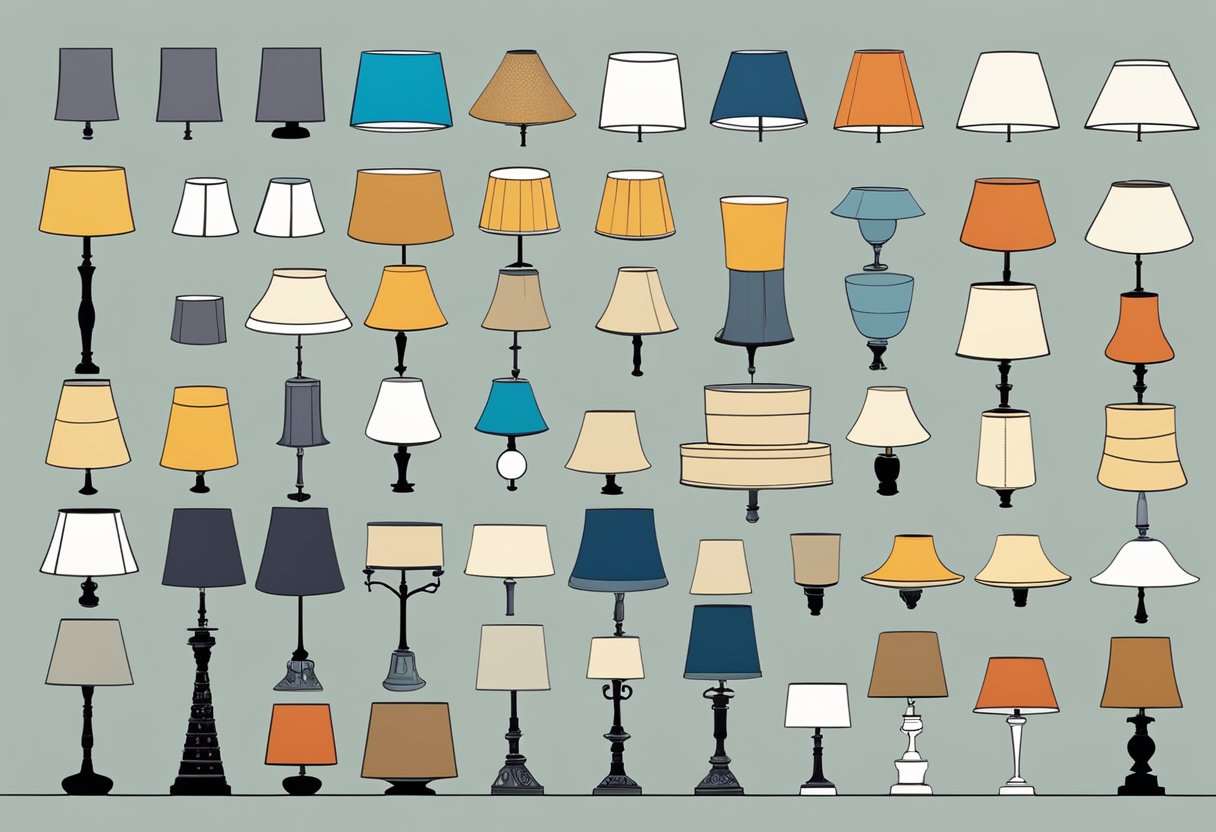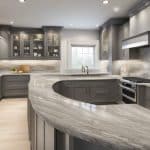Types Of Lamp Shades
Lamp shades are an essential accessory for any lamp. They not only add style and decor to a room but also help control the quality and direction of light. There are many types of lamp shades available in the market, each with its unique style, shape, and material. Understanding the different types of lamp shades and how to choose the right one can be a daunting task.
The first step in choosing the right lamp shade is to understand the shape of the shade. The shape of the lamp shade can have a significant impact on the amount and direction of light it emits. Round, square, bell, and dome shapes are the most common shapes of lamp shades. Each shape has its advantages and disadvantages, and choosing the right one depends on the lamp’s style and lighting needs.
Choosing the right material for a lamp shade is also crucial. Lamp shades come in various materials such as fabric, glass, metal, and paper. Each material has its unique properties and can affect the quality and direction of light. The material of the lamp shade can also impact the overall style and decor of a room.
Key Takeaways
- Understanding the shape of the lamp shade is crucial in controlling the amount and direction of light.
- Choosing the right material for the lamp shade can impact the quality and style of light.
- Proper size and proportion considerations, attachment styles, and fittings are also essential in selecting the right lamp shade.
Understanding Lamp Shade Shapes

When it comes to lamp shades, there are a variety of shapes to choose from. Each shape offers its own unique look and feel, as well as different lighting effects. Here are some of the most common lamp shade shapes to consider:
Drum and Empire Shades
Drum shades are cylindrical in shape and have straight sides. They are a popular choice for contemporary and modern decor styles. Empire shades, on the other hand, have a more traditional look with a tapered shape that flares out at the bottom. They are ideal for classic or traditional decor styles.
Bell and Coolie Shades
Bell shades have a curved shape that flares out at the bottom and tapers towards the top. They are a versatile choice that can work well with a variety of decor styles. Coolie shades have a similar shape to bell shades, but they are more shallow and have a wider opening at the top. They are often used for task lighting, such as reading lamps.
Square and Hexagon Shades
Square shades have a boxy shape that can add a modern touch to your decor. They are often used for table lamps and floor lamps. Hexagon shades have six sides and are a popular choice for chandeliers and other hanging fixtures. They can add a unique touch to your decor and create interesting lighting effects.
When choosing a lamp shade shape, it is important to consider the size and style of your lamp base. A cylindrical shape, such as a drum shade, can work well with a variety of lamp bases. A rectangular lamp shade, on the other hand, is best paired with a rectangular lamp base. An oval shade can work well with both round and rectangular lamp bases.
Overall, the shape of your lamp shade can have a big impact on the look and feel of your space. By choosing the right shape for your lamp, you can create the perfect ambiance for any room in your home.
Choosing the Right Material
When it comes to lamp shades, the material used can make all the difference in the overall look and feel of the room. There are a variety of materials to choose from, each with their own unique characteristics and benefits. Here are some of the most popular materials for lamp shades:
Fabric Shades
Fabric shades are a popular choice for their versatility and variety. They come in a range of materials, including linen, silk, cotton, and burlap, each with its own texture and appearance. Fabric shades are great for diffusing light and creating a warm, inviting atmosphere. They are also easy to clean and maintain.
Glass and Crystal Shades
Glass and crystal shades are a great choice for those looking for a more elegant and sophisticated look. They come in a variety of styles and designs, from simple and understated to ornate and intricate. Glass and crystal shades are also great for creating a dramatic effect with light, as they reflect and refract light in unique ways.
Metal and Wood Shades
Metal and wood shades are a great choice for those looking for a more rustic or industrial look. They come in a range of materials, including metal, wood, rattan, and bamboo, each with its own unique texture and appearance. Metal and wood shades are also great for directing light in specific directions, making them ideal for task lighting.
When choosing a lamp shade, it is important to consider the material used and how it will fit in with the overall style and decor of the room. Whether you are looking for a warm and inviting atmosphere or a more modern and sophisticated look, there is a lamp shade material that is sure to meet your needs.
Lamp Shades and Light Quality
Lamp shades not only add style and personality to a room, but they also play a crucial role in determining the quality of light that a lamp produces. Understanding the different types of lighting and how lamp shades affect them can help you choose the right shade for your needs.
Ambient vs. Task Lighting
Ambient lighting is the general lighting in a room that provides overall illumination. It is usually soft and indirect, creating a warm and inviting atmosphere. Task lighting, on the other hand, is more focused and direct, providing bright light for specific tasks such as reading or working.
The type of shade you choose can affect the type of lighting that a lamp produces. A shade that diffuses light, such as a fabric or paper shade, is ideal for creating ambient lighting. A shade that directs light, such as a metal or glass shade, is better for task lighting.
Shade Colors and Patterns
The color and pattern of a lamp shade can also affect the quality of light that a lamp produces. Shades that are light in color, such as white or cream, allow more light to pass through, creating a brighter and more cheerful atmosphere. Shades that are dark in color, such as black or navy, absorb more light, creating a more subdued and intimate atmosphere.
Patterns on lamp shades can also affect the quality of light. Shades with large patterns or designs can cast interesting shadows on walls and ceilings, while shades with small patterns or solid colors produce a more uniform light.
In conclusion, understanding the different types of lighting and how lamp shades affect them can help you choose the right shade for your needs. Whether you are looking for ambient lighting or task lighting, the color, pattern, and material of a lamp shade can make a big difference in the quality of light that a lamp produces.
Size and Proportion Considerations
When it comes to selecting a lamp shade, size and proportion are important factors to consider. Choosing the right size and shape can make a significant difference in the overall look and feel of a room. Here are some key considerations to keep in mind:
Measuring for the Perfect Fit
Measuring your lamp base is the first step in determining the appropriate size for your lamp shade. As a general rule, the shade should be twice as wide as the lamp base, and one-third of the total height of the lamp. For example, if your lamp base is 6 inches wide, your shade should be at least 12 inches wide.
To determine the height of your lamp shade, measure the distance from the base of the lamp to the bottom of the socket. For table lamps, choose a shade that is two-thirds of that measurement. For floor lamps, measure from the floor to the bottom of the socket and opt for a shade that is one-fourth to one-third of that distance.
To determine the total diameter for your new lamp shade, measure across the light at the widest part (usually the very bottom of the base) and multiply this measurement by two.
Balancing Shade with Lamp Base
The proportions of the lamp shade should be balanced with the lamp base. A shade that is too small will make the lamp look top-heavy, while a shade that is too large will overwhelm the base.
When selecting a shade, consider the shape of the lamp base. A round base may look best with a round or square shade, while a rectangular base may be better suited for a rectangular shade.
It’s also important to consider the overall style of the lamp and how it fits in with the rest of the room. The lamp and shade should complement the furniture and other d√©cor in the space.
By taking these size and proportion considerations into account, you can choose a lamp shade that not only looks great but also provides the right amount of light and serves as a focal point in your living space.
Attachment Styles and Fittings
When it comes to lampshades, there are a few different attachment styles and fittings to consider. Understanding the different types of fittings can help you find the right lampshade for your lamp and ensure a secure fit.
Spider and Harp Fittings
Spider and harp fittings are the most common types of lampshade fittings. A harp is a metal wire that attaches to the lamp and supports the lampshade. The spider is a metal frame with arms that attach to the harp. The lampshade then sits on top of the spider and is secured in place with a finial.
Uno and Clip-On Attachments
Uno and clip-on attachments are less common but still important to consider. Uno attachments have a threaded ring that screws onto the lamp socket, and the lampshade then sits on top of the attachment. Clip-on attachments, as the name suggests, clip onto the light bulb itself. These attachments are best for smaller lamps or where a harp is not available.
Different styles of lampshades require different fitters to ensure a secure fit. The most common fitters include the spider, uno, and clip-on. It is important to measure the lamp and the lampshade before making a purchase to ensure the right fit. By understanding the different attachment styles and fittings available, you can find the perfect lampshade for your lamp and add a touch of style to your home decor.






